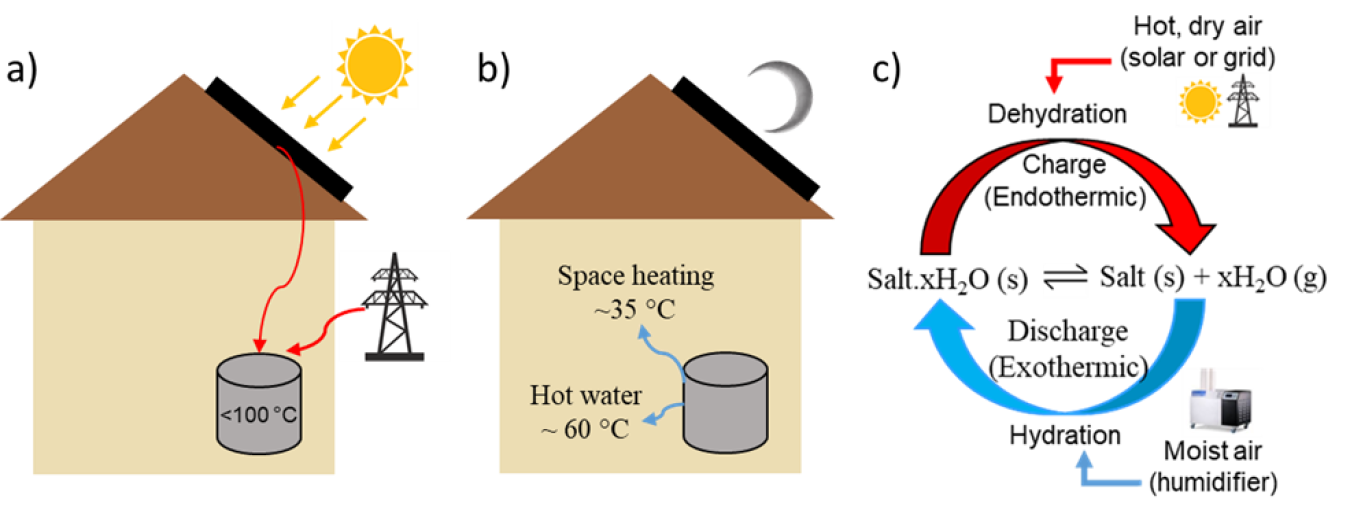Lead Performer: Lawrence Berkeley National Laboratory – Berkeley, CA Partners: -- National Renewable Energy Laboratory - Golden, CO -- UC Berkeley – Berkeley, CA -- NETenergy – Chicago, IL
March 24, 2021
a) TCMs can be charged using solar energy or grid electricity. b) Energy stored in TCM can be discharged at desired T for thermal end-uses. c) Reversible solid-gas reactions (salt hydrate) in an open system.
Lead Performer: Lawrence Berkeley National Laboratory – Berkeley, CA
Partners:
-- National Renewable Energy Laboratory - Golden, CO
-- UC Berkeley – Berkeley, CA
-- NETenergy – Chicago, IL
DOE Total Funding: $2,400,000
FY20 DOE Funding:
Cost Share: $600,000
Project Term: October 1, 2020 – September 30, 2023
Funding Type: Buildings Energy Efficiency Frontiers & Innovation Technologies (BENEFIT) 2019
Project Objective
Lawrence Berkeley National Laboratory (LBNL) will lead the project team in developing thermochemical materials (TCMs) based thermal energy storage as TCMs have a fundamental advantage of significantly higher theoretical energy densities (200 to 600 kWh/m3) than PCMs (50 - 150 kWh/m3) because the energy is stored in reversible reactions. This, along with negligible self-discharge as energy is stored in chemical bonds, makes them uniquely suited as compact, stand-alone solutions for daily-seasonal energy storage in buildings. TCMs can be used as a thermal battery that can be charged using solar energy or excess grid electricity and discharged for thermal end-uses in buildings such as space and water heating. Although promising, the available research shows TCM-based storage suffers from instabilities, both at the material and reactor level, resulting in poor multicycling efficiency and high cost of thermal energy storage. This project aims to fundamentally investigate TCMs to overcome these challenges by developing new design rules at both the material and reactor level.
The project seeks to bridge the gap between the high theoretical storage potential of thermochemical salt hydrates (>600 kWh/m3) and their sub-par performance when integrated into thermochemical reactors for energy storage with repeated cycling (<70 kWh/m3, and fewer than 20 cycles). In order to overcome the key technical challenges of salt stability under thermal cycling and poor heat and mass transport, this project will develop solutions at two levels: (i) material level, where issues from molecular to particle to composite level will be addressed such that 1-2 salt hydrates with theoretical storage density >500 kWh/m3, charging temp < 100 °C, with very high multicyclic stability could be developed; (ii) reactor-level, where a reactor, which can take up to 10 slabs of 6” x 6” TCM slabs using plate frame design, will be developed and optimized for vapor and heat transport, to demonstrate reactor-level storage capacity >100 kWh/m3 (and the stretch goal of >200kWh/m3) at a cost below $15/kWh.
During the project multiscale (particles to reactor level) Chemical-Mechanical-Thermal models will be developed to guide material selection, particle size, composite and the reactor design. A techno-economic analysis (TEA) based on key process and manufacturing parameters will also be carried out to identify main cost and performance drivers.
Project Impact
This project will significantly advance the state of the art in thermochemical energy storage. It's critical to address core science and engineering challenges that limit the realization of high energy densities and reliable performance of TCMs in practical applications. One such challenge is a lack of fundamental understanding of mass and heat transport properties that drive critical properties, such as charge/discharge rates, thermochemical reaction kinetics and long-term thermal stability Addressing these core technical challenges will open pathways for TCM-based storage (at different scales, from day-night to seasonal) to provide grid-interactive energy efficiency and flexibility in the U.S. building sector. Adoption of TCM-based storage for thermal end-uses in buildings gives a primary energy savings potential of ~ 1.7 Quads. Given that TCMs (salt hydrates) are inexpensive materials, have energy densities that are at least 10x higher than paraffin wax PCMs and are stand-alone units that do not require integration in the building envelope (reduced labor cost), the payback period is projected to be less than five years.
Contacts
DOE Technology Manager: Sven Mumme
Lead Performer: Sumanjeet Kaur, Lawrence Berkeley National Laboratory

